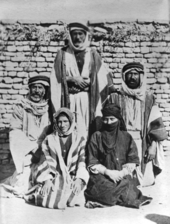| Part of a series on |
| Forced labour and slavery |
|---|
 |






Slavery existed in the territory of the modern state of Iraq until the 1920s.
When the area later to become the modern state of Iraq was a center of the Abbasid Caliphate (750–1258), the area was a major slave trade destination, and slaves were imported to Iraq from the North along the Volga trade route, from the West via the Red Sea slave trade, and from the South from the Indian Ocean slave trade. The slave trade to, and slavery in the area continued during subsequent rulerships, and Ottoman Iraq (1534-1920) remained a destination of the international slave trade in the Middle East.
Under the First World War, Ottoman Iraq came under rulership of the British, who disliked slavery. Slavery was formally abolished in Iraq in 1924. Iraq was the first Gulf state, in which slavery was banned. Many members of the Afro-Iraqi minority are descendants of the former slaves.
In the 21st-century, Islamic terrorists again practiced slavery in areas under their control in Syria and Iraq.
